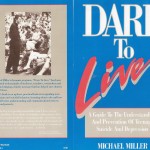I’ve been dealing a little with symbolism. In this post I want to discuss symbolic characters in the gospel of Mark. I want to show that while they may be historical they are certainly also symbolic. The symbolic characters are both named and unnamed.
A symbol is a tangible representation of an intangible idea. Symbols help to capture large abstract concepts so that they can be quickly grasped with the mind or hand. Instead of an author telling us what a character thinks, symbols reveal a character’s attitude toward the symbolic idea. Symbolic characters demonstrate in there person the faults and ideals of the gospel.
Here are three symbolic charachters in the GOspel of Mark
1. Twice Healed Blind Man
Mark records the partial healing of the blind man to illustrate Jesus healing of his disciples partial understanding. Like the partially healed blind man, the disciples see that Jesus is the Christ but they see only in part. Jesus is the Christ but not the Christ of their expectations. It takes a process to open their eyes.
The two-part healing of the blind man (8:22-26) is sandwhiched between Jesus’ rebuke of the disciples for their lack of understanding (8:14-21) and Jesus’ direct question to his disciples, “Who do you say that I am” to which Peter rightly responds, “You are the Christ.” (8:27-30).
- Jesus rebukes disciples for lack understanding. “Do you have eyes but fail to see…?” (8:14-21)
- Two-Part Healing of the blind man (8:22-26)
- Peter rightly declares Jesus “the Christ.” (8:27-30)
But Mark quickly shows Peter’s understanding as only partially correct. Jesus immediately begins to teach what it means for him to be the Christ.
He then began to teach them that the Son of Man must suffer many things and be rejected by the elders, the chief priests and the teachers of the law, and that he must be killed and after three days rise again. (8:31).
Peter will have none of it. This isn’t what he meant when he said, “You are the Christ.” The title “Christ” in the mind of the Jews carried with it all sorts of expectations that were inconsistent with the suffering message of Jesus. The disciples believed that the Christ was going to be an earthly king, a conquering hero, a military leader who would kick the Romans off of Jewish soil. But Jesus understanding of this title was quite different from Peter’s; he viewed his mission as one of suffering and a death for the sins of the world.
Jesus gathers his disciples and teaches them what it means to follow him.
“Whoever wants to be my disciple must deny themselves and take up their cross and follow me. For whoever wants to save their life will lose it, but whoever loses their life for me and for the gospel will save it.” (8:34-35)
This pattern (prediction, pride and paradox) will be repeated two more times on Jesus’ journey to Jerusalem.
- Jesus predicts his arrest, death and resurrection (8:31, 9:31, 10:33-34).
- The disciples demonstrate pride in Jesus’ role as an earthly ruler (8:33, 9:33-34, 10:35-40).
- Jesus teaches a corrective paradox (8:35, 9:35, 10:43-44).
This section (Mark 8:22-10:45) is bookended on either side by the healing of blind men. The first is the two-part healing of the blind man at Bethsaida (8:22-26) and the one time healing of blind Bartimaeus in Jericho (10:46-52). Bartimaeus interestingly enough is the only person in Mark to call Jesus, “Son of David,” echoing Peter’s confession to Jesus being the “Anointed One” two chapters prior.
The section leading up to Jesus healing of blind Bartimeaus in Mark 10, is thus revealed to be, like the two part healing of the blind man, the healing of the disciples partial sight. They saw that Jesus was the Christ but they did not see fully what this entailed.
2. Blind Bartimeous
Blind Bartimeous is the counter part to the healing of the paritally healed man. Like the disciples he sees that Jesus is the Christ, the “Son of David” When Jesus heals his partial sight. Bartimeous follows him on the road.
2. Naked Runner in Gethsemane
Whatever the naked man’s identity, he’s clearly a symbol in Mark. Note the ways in which he embodies the disciples.
He’s “following Jesus.” ”Following” for Mark is the essence of discipleship. Three times Jesus calls men to follow him and each time they leave everything to follow him (1:14-20, 2:13-14). The five men (Peter, Andrew, James, John, Levi) form his core. In all, He chooses twelve men so “that they might be with Him” (3:13-14). When Jesus returns to his hometown, Mark poignantly adds they, “followed him” (6:1). In “following Jesus” the young man is acting like a disciple.
He’s “wearing nothing but a linen garment.” Two “linen” garments are mentioned in Mark. The other is wrapped around the dead body of Jesus (15:46). Given Mark’s penchant for symbolic connections, it looks like the linen garment here represents the death Jesus has called his disciples to die. On the road to Jerusalem, after prophesying his own death, Jesus teaches his disciples,
If anyone would come after me, he must deny himself and take up his cross and follow me. For whoever wants to save his life will lose it, but whoever loses his life for me and for the gospel will save it.
Dietrich Bonhoffer aptly said, “When Christ calls a man, He bids him come and die.” The linen represents that death.
“He fled naked, leaving his garment behind.” The disciples left everything to follow Jesus (1:14-20, 2:13-14, 10:28). By deserting him, they left the one thing that still remained – the call to follow Jesus. The “young man” likewise leaves the linen garment and embraces his nakedness, the biblical symbol for shame (Genesis 2:25, 3:7-11, 9:20-29, Exodus 20:26, Isaiah 47:1-15, Revelation 3:17).
4. Simon of Cyrene
Simon of Cyrene is included as the ideal disciple, the one who picks up the cross and follows Jesus.















